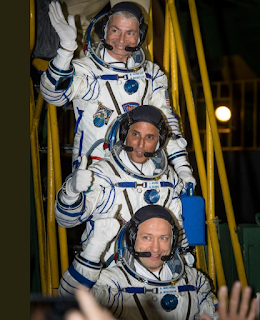Space Voyagers prepare to bard their spacecraft. Top to bottom: Alexander Misurkin, Joe Acaba, Mark Vande Hei.
As we approach the time for summer to transition to fall, one spacecraft arrived at ISS while another took its leave. Soyuz MS-06 lifted off from Baikonur on Tuesday, carrying the second half of the Expedition 53 crew. The Soyuz was piloted by Soyuz commander Alexander Misurkin (Roscosmos), and flight engineers Joe Acaba and Mark Vende Hei both of NASA. Both Misurkin and Acaba are veterans of previous space missions. Vande Hei is making his first trip into space. The crew will stay aboard the International Space Station for five and a half months, eventually becoming the lead half of Expedition 54.
Soyuz rocket departs at night from Baikonur.
The crew joins Expedition 53 Commander Randy Bresnik and flight engineers Sergey Ryazanskiy (Roscosmos) and Paolo Nespoli (ESA). As well as working on over 200 experiments in the next half year, the team is preparing for three spacewalks during October.
After undocking, the Dragon gently moves away from the ISS before commencing re-entry procedures.
On the 17th, the SpaceX Dragon unmanned cargo ship undocked and was moved awy from its berth by the robotic arm, under the control of astronaut Bresnik. Once at a safe distance, ground engineers fired the descent thrusters and slowed the craft for re-entry. Splashdown in the Pacific off of California took place at 10:14 a.m. This had been the 12th resupply mission with Dragon for SpaceX.
Space Station parking before the Dragon left the station.










